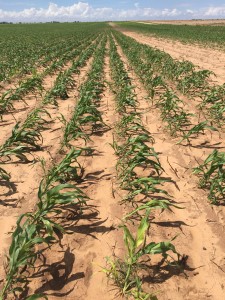Statewide
As Dr. Ronnie Schnell noted in the previous Sorghum Tip, Central Texas flooding conditions and saturated soils are cause for concern on sorghum growth and development. Texas High Plains grain sorghum that was planted early (late April and early May) has seen unprecedented rainfall as well though saturated and flooding conditions are less likely. Either case can lead to a lot of foliar and growth & development symptoms. It is difficult to know what we are looking at as some symptoms may appear similar.
For example, the traditional “interveinal chlorosis” that is associated with iron deficiency, and which grain sorghum is much more susceptible to than most crops, is normally green veins in the leaves with yellow in between. But this is not the only nutrient that may cause such a symptom. Zinc and sulfur can cause symptoms that might be confused with iron deficiency (yellowing, less pronounced striping in the leaves). Add in the general yellowing that can occur from nitrogen deficiency, and you have a difficult time deciding what is occurring. Tissue testing can be conducted, but sometimes the “normal” ranges in the leaves, for example, may not give you an accurate indication. And what standard leaf ppm is being used as a reference? These reference levels are not all the same.
Though this publication is dated and the pictures are old, I find this 1980s Australian resource “Nutritional Disorders of Grain Sorghum” to be as thorough as any in the description of nutrient deficiency and toxicity symptoms. See http://ageconsearch.umn.edu/bitstream/118045/2/2.pdf
Waiting 7-10 Days…
When soils are flooded, temperatures are cold, or you have had a hail, sometimes 7 to 10 days is all it takes to “tell the story” of a grain sorghum crop or other crop turning around. Examples in Central & South Texas, the Texas South Plains, etc. currently reveal what draining and drying soil, warmer temperatures, and sunshine can do for a crop. Much of the Texas sorghum crop has a limited root system due to either flooding, as Dr. Schnell noted, or simply not needed to root deeply for moisture. But as drier, aerating conditions in the soil return, root volume will begin to expand. This often fixes a lot of foliar leaf symptoms—watch for new leaves appearing in the whorl and recently emerged leaves to return to near normal green coloration. This is a good sign.
Sorghum and Brace Roots—Key to Standability
The above picture, courtesy of Tate Newsom in Terry Co., shows grain sorghum that has leaned over from a strong wind. I would not call this lodged sorghum (which often involves stalk breakage). This sorghum is planted flat, and is at a stage of growth where the brace roots are just starting to emerge from the base of the stalk. Given time, these roots will anchor the stalk and stand the plant up. Where grain sorghum can struggle in this type of situation is 1) the sorghum is planted on top of a bed (that does not fit the type of plant and the root system of grain sorghum, but it works OK for taproot crops like cotton); you can’t very well throw soil with cultivation ‘uphill’ to cover the brace roots, and hard rains can wash soil away from brace roots entering the soil; b) soils are hot and dry, and thus roots don’t as easily enter the soil. If you still use cultivation for weed control, when you throw soil around the base of the sorghum plant, the brace roots are then already in the soil when they emerge. This is a win-win for grain sorghum and the producer, and you may have buried a few small weeds in the process.
Fading Weed Control from Pre-Plant/Pre-Emerge Herbicides
We are receiving numerous reports that “weeds are coming” where excessive rainfall has occurred and early atrazine (or propazine, particularly on sandier soils in a cotton rotation) appear to have shortened weed control. Be ready to promptly address in-season weed control needs. Many producers are well past the window for using 2,4-D or dicamba. See the earlier June edition of Sorghum Tips for additional in-season options. Could you possibly consider additional atrazine if sorghum is still 12” tall or less? This might be a consideration, but how readily you would decide to add more might depend on your crop rotation goals. Talk to your chemical dealer, company rep, or our AgriLife weed scientists if you need options. AND… scout your fields for weeds. They grow faster than our kids! Do your best to not let them get away, remembering the smaller weed size is easier to control. I assert that if you ever find yourself asking/doubting “Should I go ahead and apply my weed control?…” based on the size of your weeds, you should probably go ahead and apply.









